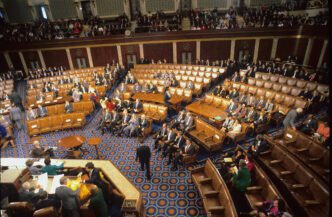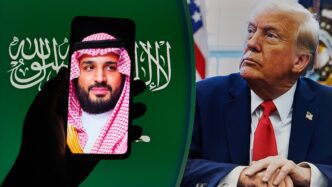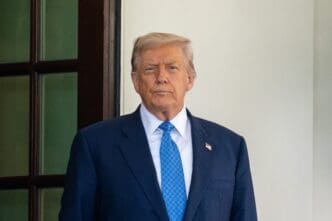MOSCOW – A special envoy for U.S. President Donald Trump met with Russian President Vladimir Putin at the Kremlin on Wednesday for a high-stakes, last-ditch diplomatic effort, just two days before a White House deadline for Russia to move toward a peace deal in Ukraine or face crippling new economic penalties.
The Kremlin publicly put a positive spin on the lengthy, three-hour meeting, with a top aide to Putin calling the talks “very useful and constructive.” However, the diplomatic overtures in Moscow were starkly contrasted by the brutal reality on the ground in Ukraine, where a fresh Russian strike on a civilian recreational center killed and injured more than a dozen people, including children, underscoring the immense gap that remains between the two sides.
The meeting is the culmination of a dramatic, high-pressure campaign by President Trump to force an end to the three-year war. Frustrated by what he sees as Putin’s disingenuous engagement in their personal phone calls, the president has set a hard deadline of this Friday for Russia to accept a U.S.-backed ceasefire. If the deadline passes without a breakthrough, Washington has threatened to unleash a wave of “severe tariffs” and other economic penalties, including punishing secondary sanctions on countries like China and India that continue to purchase Russian oil.
A Tale of Two Realities: Diplomacy in Moscow, Destruction in Ukraine
The Kremlin’s public statements following the meeting were cautiously optimistic, a familiar tactic in its diplomatic playbook. Putin’s long-time foreign policy aide, Yury Ushakov, told Russian state media that “very useful and constructive” talks had covered both the war in Ukraine and the broader state of U.S.-Russia relations.
“Our side has forwarded some signals, in particular on the Ukrainian issue, and corresponding signals were received from President Trump,” Ushakov said, though he refrained from providing any specific details. He added that Russian officials were now waiting to see how the U.S. envoy would report the conversation back to President Trump before making any more substantial comments.
Earlier in the day, the U.S. envoy was seen taking an early morning stroll through a park near the Kremlin with a key Russian official involved in previous, unsuccessful rounds of peace talks, a carefully choreographed photo opportunity designed to project an atmosphere of calm dialogue.
But just as these diplomatic scenes were unfolding, the grim reality of the war continued unabated. Overnight, Russian forces launched a deadly strike on a recreational center in Ukraine’s southern Zaporizhzhia region, killing two people and injuring twelve, including two children, according to the regional governor. Ukrainian officials said the area was hit with powerful glide bombs.
“There is zero military sense in this strike. Only cruelty to intimidate,” Ukrainian President Volodymyr Zelenskyy said in a post on Telegram, a sentiment that captures the deep skepticism in Kyiv and among Western analysts about Putin’s willingness to engage in serious negotiations.
A High-Stakes Deadline Looms
The meeting in Moscow comes at a critical inflection point. President Trump, who has expressed increasing personal frustration with Putin, has staked significant political capital on his ability to force a resolution. His initial 50-day deadline for a ceasefire was moved up as the Kremlin continued to escalate its bombing campaigns against Ukrainian cities, even as the two leaders were engaged in direct talks.
The primary weapon in the U.S. arsenal is the threat of massive secondary sanctions. The administration has made it clear, both publicly and privately, that it is prepared to impose crippling tariffs on nations that continue to be economic lifelines for Moscow by purchasing its oil. This would put immense pressure on China and India, the two largest buyers of Russian fossil fuels.
“We have a meeting with Russia tomorrow,” Trump told reporters on Tuesday, referring to the envoy’s visit. “We’re going to see what happens. We’ll make that determination at that time.”
Stepping up this economic pressure, however, comes with significant risks of stoking broader international tensions at a time when U.S.-Russia relations are already at a historic low. The Washington-based Center for European Policy Analysis warned in an assessment this week that there are “clear signs that the Kremlin is preparing for a broader confrontation with NATO,” pointing to a significant Russian military build-up along its western flank.
A Calculated Stall or a Path to Peace?
For their part, Putin and senior Kremlin officials have given no public indication that they are ready to make concessions. Instead, they have recently ramped up their rhetoric, talking up the country’s military strength. Just last week, Putin announced that Russia’s new, supposedly unstoppable hypersonic missile had entered service. Former Russian President Dmitry Medvedev recently warned that the Ukraine war could bring Russia and the U.S. into direct armed conflict, a threat that prompted Trump to order the repositioning of two U.S. nuclear submarines.
Most Western analysts and Ukrainian officials believe that Putin is merely stalling for time, using the diplomatic track to create the illusion of progress while his forces continue their push to capture more Ukrainian territory. The current Russian offensive, which began in the spring, is advancing faster than last year’s push but is still making only slow and costly gains, unable to take any major cities. While the situation on the front line is critical for Ukrainian forces, analysts say their defenses are not on the verge of collapse.
The ultimate question is whether the immense economic pressure threatened by Washington will be enough to force a genuine recalculation in the Kremlin. President Trump himself has expressed doubts about the effectiveness of sanctions against Moscow, saying on Sunday that Russia has proven to be “pretty good at avoiding sanctions.”
“They’re wily characters,” he said of the Russians.
As the Friday deadline approaches, the world is now watching to see if this latest, high-stakes diplomatic gambit can break the bloody stalemate, or if it will simply be another prelude to a new and more dangerous phase of economic and military conflict.








